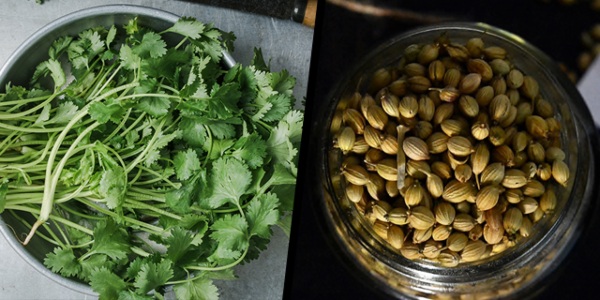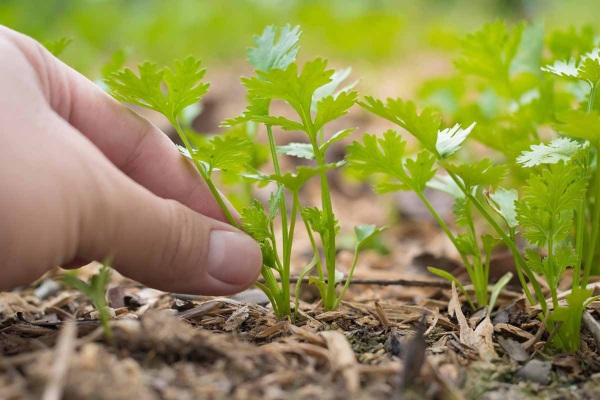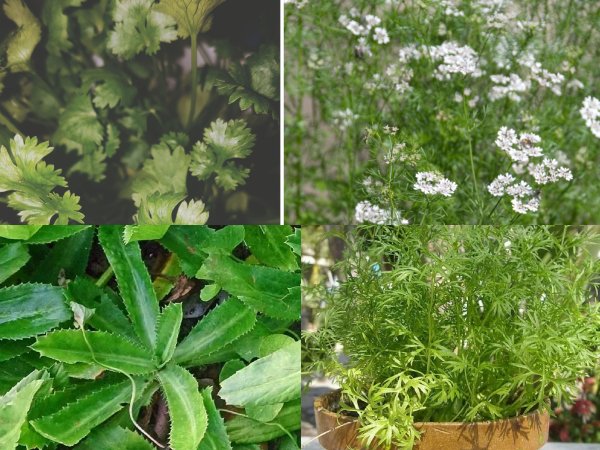Cilantro, also known as coriander or Chinese parsley, is a leafy green herb that comes from the coriandrum sativum plant. It is a versatile herb widely used in global cuisine. The word “cilantro” is the Spanish moniker that refers to the coriander leaves.
Cilantro is known for its sharp, tangy, almost citrus-like flavor and strong fragrance. Cilantro is a staple in Asian, South American, and Central American culinary traditions, adorning dishes and enhancing flavors in sauces and salads. Beyond its culinary uses, cilantro is believed to possess antioxidant and anti-inflammatory properties, contributing to potential health benefits.
In this article, we will explore the types of cilantro, how it is different from coriander, and how to grow it.
Are Cilantro and Coriander the Same?
Cilantro and Coriander both come from the Coriandrum sativum plant. However, they are named differently based on how they are used and where they are grown. In the U.S., cilantro refers to the leafy green part and stems, while the seeds are called coriander seeds. Internationally, the leaves and stems are called coriander, and the dried seeds are referred to as coriander seeds. Despite being from the same plant, they are very different in flavor and cannot be swapped in recipes. Fresh cilantro has very green and aromatic leaves, ideal for garnishing dishes, whereas coriander seeds offer a warm, spicy taste, often used in curries and meat rubs.
Appearance

Cilantro and coriander differ in appearance primarily due to their parts used and stages of growth. It has soft, feathery bright green leaves and thin stems. It smells fresh and citrusy. On the other hand, coriander are seeds that are small, round, and brown.
Flavor and Smell
Cilantro and Coriander offer distinct flavors and smells. Cilantro brings a zesty, citrus-like taste and aroma, while coriander presents a warmer and spicier. Some people don’t like cilantro because of their genes, finding it soapy, while many enjoy its freshness. Conversely, coriander smells warm, spicy, and nutty, with a little bit of citrus. It is often used with cumin and cinnamon because they taste similar.
Uses
Cilantro and coriander are used differently in cooking because they have different flavors. The freshness and citrusy taste of cilantro makes it a popular garnish in South American, Mexican, South Asian, Chinese, and Thai dishes. People often add fresh cilantro to dishes like salsa, guacamole, chutney, and acorda just before serving to keep its flavor strong.
On the other hand, coriander seeds have a warmer, spicier flavor. They are used in dishes like curries, rice dishes, soups, stews, and meat rubs. Dry roasting to heating coriander seeds can make them taste even better, but ground or powdered seeds lose their flavor quickly, so it’s better to use fresh seeds.
Nutrient
Even though they are from the same plant, cilantro and coriander have different nutrients. Cilantro leaves are rich in vitamins like A, K, and E, but they have fewer minerals like manganese, iron, magnesium, and calcium. On the other hand, coriander seeds have fewer vitamins but more minerals. Similarly, cilantro is mostly water, but coriander seeds have almost none. Since water doesn’t have minerals or calories, cilantro has fewer minerals per weight than coriander seeds.
Growing Cilantro: Essential Care and Growth Tips

Cilantro is a popular herb known for its delicious taste and easy cultivation. It is best planted in the early spring or fall. It grows quickly, with leaves ready to harvest in about a month and seeds available in roughly three months. Here is a step-by-step guide to effectively growing cilantro, as well as some care tips to ensure healthy produce.
Select Right Location
When planting cilantro, choose a spot that gets some sunlight, preferably partial to full sunlight. It likes cooler temperatures and soil that drains well. Cilantro does best with about six hours of direct sunlight each day. But be careful not to put it where it will get too much harsh sunlight at midday, as this can burn the leaves.
Soil Preparation
Cilantro thrives in well-draining, nutrient-rich soil that has a pH between 6.2 and 6.8. The perfect soil for cilantro is loose, loamy, and drains quickly, with a slightly acidic pH. If the soil holds too much water, the plant might start making seeds too soon.
Planting Seeds
Plant cilantro seeds directly in your garden or pots. Put them about 1 to 2 deep and space them 6 to 8 inches apart. Keep rows of cilantro at least a foot apart so air can move around them well.
Watering
Make sure the soil stays damp, but not too wet. Water cilantro plants regularly, especially when it is dry, to stop the soil from drying out. But when the plants are older, they don’t need as much water, but they still like the soil to be damp. Just don’t let the waterlogged.
Fertilizing
Give the soil some balanced fertilizer or compost to keep it healthy. Don’t give cilantro too much fertilizer, though. Mix some compost or other organic stuff into the soil when you first plant the seeds to help the plants grow well.
Types of Cilantro
Cilantro comes in various types, each distinguished by its leaf shape, flavor intensity, and growth habit. Here are some of the common varieties, each with its unique characteristics.
Delfino Cilantro
Delfino cilantro has thin, fern-like leaves that don’t need much chopping, making it perfect for dishes like lime cilantro yogurt sauce and a great dip for fresh veggies. It produces bunches of foliage ready to harvest in 35 days and sets seed in 80 to 85 days. Delfino’s flavor is very similar to that of common cilantro.

Calypso Cilantro
Calypso cilantro is very slow to bolt, taking 50 to 55 days to mature and not going to seed until 120 to 150 days. While other types of cilantro start flowering and setting seed, Calypso remains bushy and productive. Its fragrance adds a distinctive flavor to broths, tacos, and many other dishes.
Leisure Cilantro
Leisure Cilantro is a productive and slow-to-bolt variety of cilantro, known for its strong flavor and bolt resistance. It matures in 50 to 55 days and sets seeds in 90 to 105 days. Its leaves are medium green, feathery, and flat with a delicious, pungent flavor.
Santo Cilantro
Santo cilantro, also known as Long Standing, Slow Bolt, and Slo Bolt, is a fast-growing variety known for its high yield, strong flavor, and good bolt resistance. It matures in 50 to 55 days and holds up well to heat with an upright growth habit. Similarly, it produces dark green leaves with great flavor, making it a favorite among gardeners.
Frequently Asked Questions
1. How many types of cilantro are there?
Cilantro comes in various types, each distinguished by its leaf shape, flavor intensity, and growth habit. Some of the common types include Santo Cilantro, Calypso Cilantro, Leisure Cilantro, and more.
2. Is cilantro a type of parsley?
No, cilantro is not a type of parsley. Although they belong to the same family, they are different plants with distinct characteristics.
3. What is unique about Delfino cilantro?
Delfino cilantro is unique for its delicate, fern-like leaves. These leaves are less common among cilantro varieties and make an attractive garnish. Despite its appearance, it has a flavor similar to common cilantro.
Also read, Nutrient-Rich Harvest: Top 10 Leafy Greens for Your Garden
